The COVID-19 pandemic has highlighted the importance of ‘S’ in ESG. As cracks in healthcare and social systems revealed themselves globally, it became even more apparent that there is a need for greater investment for the most vulnerable communities in order to secure a sustainable future. During this time, indigenous peoples have been disproportionately affected due to socioeconomic disparities and limited access to quality healthcare. However, indigenous groups have always faced huge social and climate risk due to their typically strong links to territories and surrounding natural resources. As a result, with the crises of the pandemic and climate change ensuing, populations find themselves particularly vulnerable to unpredictability, resource exploitation and a lower quality of life.
Indigenous Knowledge & Climate Resilience
There are believed to be between 370 and 500 million indigenous peoples worldwide, in over 90 countries. Despite making up 5% of the global population, they live amongst an estimated 80% of the world’s remaining biodiversity. Thus, their role in the future of climate change and sustainability is integral. However, climate resilience does not just involve the protection of biodiversity, but crucially, it entails addressing social concerns. By building resilience through adaptive measures, natural resources can be better managed and social inequalities can be better addressed. This being said, with increasing pressure on companies worldwide to make the transition towards a greener outlook, indigenous peoples have become vulnerable to greenwashing attempts. Self-proclaimed corporate responsibility has become increasingly sophisticated across companies and has engendered the continued exploitation of indigenous land whilst maintaining a ‘green’ image, whilst other projects have received criticism for failing to trickle down to the those living on the ground.
A wealth of generational knowledge concerning ecosystems, agricultural practices and energy conservation are embedded in indigenous climate-adaptation techniques. Indigenous-led solutions have been scientifically validated as highly effective responses to climate change and increased sustainability. Consider the
- Kichwa Sarayaku people in Ecuador who prepared the proposal “Kawsay Sacha” to protect forests and keep fossil fuels in the ground utilizing knowledge from within their own communities
- Similarly, the Green Climate Fund project in northern Pakistan, that prioritises indigenous groups as their key stakeholders to combat melting glaciers
Both exemplify the importance of indigenous knowledge integration and active participation to combat climate change; and crucially, the need to attract capital into these communities.
Challenges
However, such projects, particularly those that grant direct leadership to indigenous peoples, can be few and far between. Generally, making investments at a local level is viewed as risky by most funders. In the case of indigenous groups, the reasons reach far deeper and links to the overarching issue of marginalization. Firstly, the systemic lack of integration into broader financial systems means that indigenous groups often lack the tools to attract capital in the first place. The indivisible nature of indigenous lands, discrimination, and poor credit histories creates a cycle that further generates the perception of high-risk investment. The resulting stigma towards indigenous communities thus disincentivizes investment. This is more so the case in countries with emergent industries, where risks are seen as even greater due to perceived limited technological literacy and poorly connected communities. Cumulatively, this has resulted in barriers for attracting finance into indigenous-led projects.
Opportunities in Sustainable Finance
Nonetheless, sustainable finance can create a tangible impact for indigenous groups. The growing attention towards ESG and the rise in impact investing presents a ripe opportunity for investments within indigenous communities. In North America, significant moves have been made to include indigenous communities in private market opportunities. Alternative investment vehicles present pathways to integrate indigenous communities into the sustainable finance space. For example, until recently in the region, the criteria for investors in private equity funds excluded indigenous people, as they were not considered ‘accredited investors’. However, in 2020, the US Securities and Exchange Commission (SEC) adopted amendments to include ‘American Indian Tribes’ as an accredited investor. The opportunity to access larger amounts of capital can be hugely impactful for entrepreneurs in these communities and allow greater negotiation and leverage to be granted on their part.
To address the investment gap more broadly, aggregation is considered a key tool, a crucial mechanism that can lead the way in addressing financing gaps in countries with emerging industries. Bundling smaller enterprises or projects together for investment, can create greater incentive for investment on larger platforms, such as through community funding mechanisms. Moreover, the mutual support between financial and development additionality guarantees greater adherence to ESG parameters, without compromising on the social aspects of indigenous livelihoods. This is especially crucial to breaking the cycle of perceived risk in indigenous areas. Thus, sustainable finance can bridge the gap between ESG promises and tangible outcomes for those who benefit the most from the ‘S’ aspect.
There is still a long way to go to finance the Sustainable Development Goals, as the trillion-dollar gap looms. More so, greater efforts towards actively integrating indigenous perspectives and goals need not be overlooked by hollow promises of sustainability; actors in the field need to remain cognizant of whether projects truly align with indigenous goals. Initiatives such as the Major Project Assessment Standard (MPAS) are already setting the standards by cataloguing procedural requirements necessary for Indigenous governments to make informed decisions on major projects. With the growing popularity of alternative financing tools and the urgency of climate change adaptation infiltrating the financial space, indigenous knowledge needs to be recognised for its value and the positive boomerang effect it can bring to indigenous communities when valued as a worthy risk.
Bibliography:
https://auctusesg.com/rising-importance-of-s-in-esg-for-private-capital-2/
https://www.fao.org/climate-change/news/detail/en/c/1301846/
https://auctusesg.com/esg-greenwashing-a-not-so-green-business-practice/
https://theecologist.org/2015/sep/23/indigenous-peoples-bear-brunt-global-greenwash
https://theecologist.org/2018/dec/13/climate-finance-and-indigenous-communities
https://www.un.org/development/desa/dspd/2021/04/indigenous-peoples-sustainability/
https://www.greenclimate.fund/news/gcf-ensures-indigenous-peoples-play-key-role-climate-action
https://www.oecd-ilibrary.org/sites/24adb253-en/index.html?itemId=/content/component/24adb253-en
https://www.iied.org/what-aggregation-how-can-it-get-climate-finance-working-for-most-vulnerable

